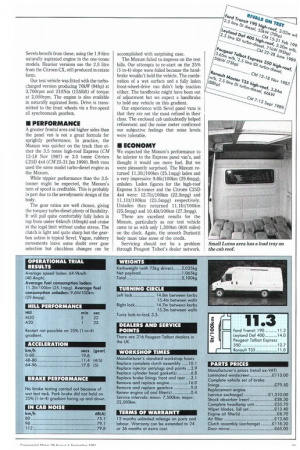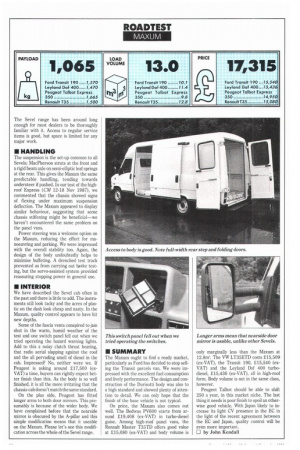MI What do you do if you need more space
Page 25

Page 26

Page 27

Page 28

If you've noticed an error in this article please click here to report it so we can fix it.
than your average panel van gives but still want to stay below 33 tonnes GVW? Highroof panel vans provide a useful increase in cube, but the top limit is around 11.5m. Alternatively, several manufacturers offer purpose-built parcels vans through their dealer networks. Ford designs and produces one through its Special Vehicle Operations (SVO) department, and Leyland Daf sells the 400-based Bedwas PV600.
Ford reckons to shift around 400 a year but the option will be dropped when the new model is introduced in the autumn. The Sevei Triplets (Fiat Ducato, Citroen C25 and Peugeot Talbot Express) have not been available in similar form, despite availability of such vehicles on the Continent.
Peugeot Talbot has changed all that by importing the Maxum. The vehicle is based on an Express chassis-cab, or the J5 as it's known in France. Bodywork is by French coachbuilder Durisotti, which also produces other special LCVs for Peugeot, including a high-cube 205 van.
The Maxum was first seen in France last year and Peugeot Talbot thinks there is sufficient demand to make it available in the UK. Principal customers are likely to be welfare bus users, ambulance services and parcels hauliers. Peugeot Talbot has already had enquiries from two parcels companies and an ambulance service. Realistically, sales will be in small numbers but Peugeot will be happy if this eventually reaches around 250 a year.
We were offered for roadtest one of the first Maxums to be imported — ours came with the turbo-diesel engine and power steering. With bus use in mind, early imports will be at 3.1 tonnes GVW, but a 3.5tormer will follow in due course.
• BODYWORK
The Durisotti body is built on a long-wheelbase Express chassis-cab. Zinc-plated steel panels on a zinc-plated welded steel frame, make up the body. ABS panels protect the lower body sides and the roof is a one-piece polyester moulding. Our test vehicle was fitted with the optional translucent roof panel which gives plenty of daylight in the load area. The cab rear window is retained too but the bulkhead can be removed if required.
The sliding side door on our test vehicle is an option, a hinged door is offered as an alternative. With an aperture width of 1,010mm, it should be possible to load a one-metre pallet. The door extends vertically to the roofline, so tall packages can be loaded from the side.
At the rear, a step runs the full width of the door aperture, complementing the low
loading platform, The doors can either be held at 90n or folded flat against the body sides, valuable in loading bays or where access is tight.
Peugeot Talbot claims a body volume of 13m, a useful increase on the 10.2m3 available from the high-roof Express 310 and 350. This compares with a claimed 16.6m3 for the Leyland Daf 400-based Bedwas PV600 and 11.9m" or 15.5m5, depending on wheelbase, for Ford's SVO Transit parcels van.
One penalty for the low loading height is a fair amount of intrusion from the rear wheel arches. Thankfully, the Maxum uses single rear wheels, otherwise the intrusion would be even greater. The load platform is otherwise free from obstructions. Tie-down eyes are also provided. Although space in the "Luton" is limited, a liner tray is fitted to the cab roof for small articles. At 1,065kg, payload is respectable for such a large body, but buyers with greater payload requirements will have to wait for the 3.5 tonne version to arrive.
Overall the standard of finish was high — the body fared in smoothly with the chassis-cab. The angled Luton is joined to the cab at the top of the windscreen, eliminating any energy sapping gap between the two. However, some attention to detail is needed. The radio aerial slapped against the Luton at speeds over 60km/h (40mph), alarming intially but soon became iritating. Also the bottom side door support protrudes from the otherwise flush-fitting panels. Minor points perhaps, but the more obvious when finish is otherwise to a high standard.
• DRIVEL INE
By common consent, the Peugeot Group (PSA) produces some of the finest light diesels for cars and LCVs. The Peugeot/Citroen Sevels benefit from these, using the 1.9 litre naturally aspirated engine in the one-tonne models. Heavier versions use the 2,5 litre from the Citroen CX, still produced in estate
form.
Our test vehicle was fitted with the turbocharged version producing 70kW (94hp) at 3,700rpm and 210Nm (155Ibft) of torque at 2,000rpm. The engine is also available in naturally aspirated form. Drive is transmitted to the front wheels via a five-speed all synchromesh gearbox.
• PERFORMANCE
A greater frontal area and higher sides than the panel van is not a great formula for sprightly performance. In practice, the Maxum was quicker on the track than either the 3.5 tonne high-roof Express (CM 12-18 Nov 1987) or 3.0 tonne Citriien C25D 4x4 (CM 25-31Jan 1990). Both vans used the same model turbo-diesel engine as the Maxum.
While nippier performance than the 3.5tonner might be expected, the Maxum's turn of speed is creditable. This is probably in part due to the aerodynamic design of the body.
The gear ratios are well chosen, giving the torquey turbo-diesel plenty of flexibility. It will pull quite comfortably fully laden in top from under 64km/h (40mph) and cruise at the legal limit without undue stress. The clutch is light and quite sharp but the gearbox action is typical Sevel. Vague, rubbery movements leave some doubt over gear selection but clutchless changes can be
accomplished with surprising ease.
The Maxum failed to impress on the test hills. Our attempts to re-start on the 25% (1-in-4) slope were foiled because the handbrake wouldn't hold the vehicle. The combination of a wet surface and a fully laden front-wheel-drive van didn't help traction either. The handbrake might have been out of adjustment but we expect a handbrake to hold any vehicle on this gradient.
Our experience with Sevel panel vans is that they are not the most refined in their class. The enclosed cab undoubtedly helped refinement and the noise meter confirmed our subjective feelings that noise levels were tolerable.
• ECONOMY
We expected the Maxum's performance to be inferior to the Express panel van's, and thought it would use more fuel. But we were pleasantly surprised. The Maxum returned 11.31it/100km (25.1mpg) laden and a very impressive 9,61it/100km (29.6mpg), unladen, Laden figures for the high-roof Express 3.5-tonner and the Citroen C25D 4x4 were: 12.71k/1001m (22.3mpg) and 11.11it/100km (25.5mpg) respectively. Unladen they returned 11.114/100km (25.5mpg) and 10.41it/100km (27.3mpg).
These are excellent results for the Maxum, particularly as our test vehicle came to us with only 1,300ksn (800 miles) on the clock. Again, the smooth Durisotti body must take some of the credit.
Servicing should not be a problem through Peugeot Talbot's dealer network. The Sevel range has been around long enough for most dealers to be thoroughly familiar with it. Access to regular service items is good, but space is limited for any major work.
• HANDLING
The suspension is the set-up common to all Sevels; MacPherson struts at the front and a rigid beam axle on semi-elliptic leaf springs at the rear. This gives the Maxurn the same predictable handling, tending towards understeer if pushed. In our test of the highroof Express (CM 12-18 Nov 1987), we commented that the chassis showed signs of flexing under maximum suspension deflection. The Maxum appeared to display similar behaviour, suggesting that some chassis stiffening might be beneficial—we haven't encountered the same problem on the panel vans.
Power steering was a welcome option on the Maxum, reducing the effort for manoeuvring and parking. We were impressed with the overall stability too. Again, the design of the body undoubtedly helps to minimise buffeting. A drenched test track prevented us from carrying out brake testing, but the servo-assisted system provided reassuring stopping power in general use.
• INTERIOR
We have described the Sevel cab often in the past and there is little to add. The instruments still look tacky and the acres of plastic on the dash look cheap and nasty. In the Maxum, quality control appears to have hit new depths.
Some of the fascia vents conspired to jam shut in the warm, humid weather of the test and one switch panel fell out when we tried operating the hazard warning lights. Add to this a noisy clutch thrust bearing, that radio aerial slapping against the roof and the all pervading smell of diesel in the cab. Impressed? No, neither were we. If Peugeot is asking around £17,500 (exVAT) a time, buyers can rightly expect better finish than this. As the body is so well finished, it is all the more irritating that the chassis-cab doesn't match the same standard.
On the plus side, Peugeot has fitted longer arms to both door mirrors. This presumably is because of the wider body. We have complained before that the nearside mirror is obscured by the A-pillar and this simple modification means that it useable on the Maxum. Please let's see this modification across the whole of the Sevel range.
• SUMMARY
The Maxum ought to find a ready market, particularly as Ford has decided to stop selling the Transit parcels van. We were impressed with the excellent fuel consumption and lively performance. The design and construction of the Durisotti body was also to a high standard and showed plenty of attention to detail. We can only hope that the finish of the base vehicle is not typical.
On price, the Maxum also comes out well. The Bedwas PV600 starts from around £19,408 (ex-VAT) in turbo-diesel guise. Among high-roof panel vans, the Renault Master T35TD offers good value at £15,080 (ex-VAT) and body volume is only marginally less than the Maxum at 12.8m'. The VW LT35ETD costs £15,509 (ex-VAT), the Transit 190, £15,540 (exVAT) and the Leyland Daf 400 turbodiesel, £15,436 (ex-VAT), all in high-roof form. Body volume is not in the same class, however.
Peugeot Talbot should be able to shift 250 a year, in this market niche. The last thing it needs is poor finish to spoil an otherwise good vehicle. With Japan likely to increase its light CV presence in the EC in the light of the recent agreement between the EC and Japan, quality control will be even more important.
0 by John Kendall
















































































